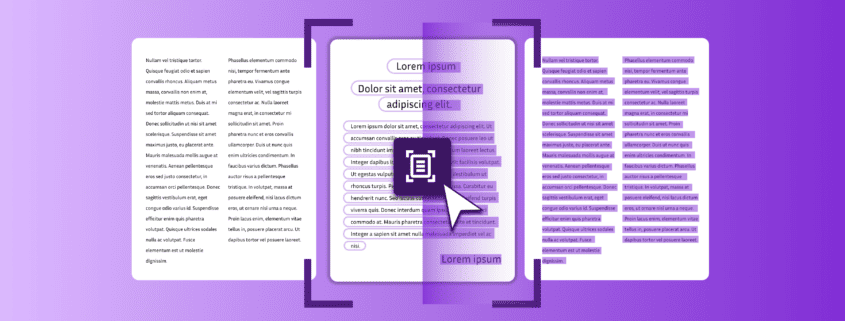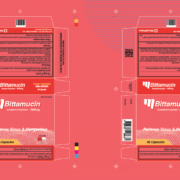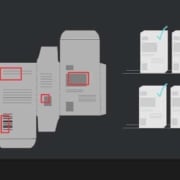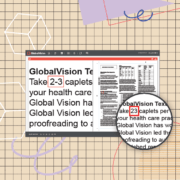OCR: Everything You Need to Know About Optical Character Recognition
Date: September, 2023 | Category: Proofreading | Author: Hana Trokic
Optical Character Recognition (OCR), is a technology that has revolutionized how we interact with text. This technology enables computers to decipher and manipulate printed, handwritten, and images of text, from an array of sources, including digital files, scanned documents, web pages, and more.
In this blog post, we’ll look into the fundamentals of Optical Character Recognition, explore the distinctions between live, rasterized, and vectorized text, and discover its versatile applications across various industries.
Read on to find out everything you need to know about OCR’s potential and how it can benefit your specific use case.
What is Optical Character Recognition?
OCR, short for Optical Character Recognition, is a transformative technology that converts printed, handwritten text or images into machine-encoded text, otherwise known as live text. It allows computers to recognize, understand, and manipulate text from various sources.
The primary goal of Optical Character Recognition is to make text more accessible and editable, enabling users to extract valuable information from physical documents or images and convert it into a digital, searchable format. Besides live text, text can also be rasterized or vectorized which makes the need for OCR crucial when editing digital assets and documents.
It is also important to note that OCR is otherwise a field of AI that focuses on recognizing and extracting text from images without live text. While Optical Character Recognition itself is a specific application within AI, it relies on various AI techniques and algorithms to perform its tasks such as machine learning.
Difference Between Live, Rasterized, and Vectorized Text
Knowing the difference between live, rasterized, and vectorized text is important in various contexts, especially when working with digital designs, graphics, and prints.
Here is a simple breakdown to help you understand their meanings and main differences:
- Live Text: Refers to text that is editable and retains its text properties, such as font, size, color, and style, within a digital document or design software. In other words, live text is dynamic and can be modified or formatted. This is the text you would see in a Word or Google document, or other writing and editing platforms.
- Rasterized Text: Refers to text that has been “flattened” or converted into a grid of pixels. Rasterized text loses its ability to be edited as text and is treated as a static image or part of an image. This would be text that is seen in a screenshot or image.
- Vectorized Text: Refers to text that is represented using vector graphics rather than pixels. In vector graphics, text is shown as shapes, positions, and attributes. This means the text is shown as a graphic within a graphic and can be edited as a shape but not as text characters. You can increase the size of the graphic and change its position, but the text itself cannot be edited.
Optical Character Recognition For Different Use Cases
Now that we understand the difference in text types, it’s important to understand how Optical Character Recognition can benefit users in real-life scenarios. Optical Character Recognition technology is valuable in a wide range of industries and applications where converting printed, handwritten text, and images into machine-readable digital text is essential.
This is especially useful in regulated industries and print and packaging during the quality review and proofreading stages of the product life cycle. Highly regulated industries have little room for error in their critical content. As such, any inaccuracies in content can lead to catastrophic consequences such as product recalls or customer safety issues. The addition of OCR in the editing and revision stages enables errors to be caught and fixed before products go out to market.
Here is a detailed look at how Optical Character Recognition is beneficial in different use cases:
- Regulatory Compliance: In situations where critical content is provided as rasterized or vectorized text, such as product information, ingredients or warning labels, and other artwork files, OCR simplifies data extraction, document quality inspections such as spell checks, and ultimately the editing process by reducing the chance of errors slipping through and costs associated with similar compliance efforts.
- Labeling Quality Control: Teams that work in labeling quality control deal with label proofs that are more often than not graphics instead of dynamic files that include live text. Because of this, Optical Character Recognition is crucial to extract the text and inspect and edit labels before they go out to production and print.
- Promotional Materials: Marketing materials, particularly in regulated industries such as pharmaceuticals, sometimes need to be reviewed in the form of PDFs, screenshots, images of webpages, and flattened email content. Additionally, global companies often deal with these assets in a multitude of foreign languages. OCR can convert this text so files can be easily inspected and edited to ensure all materials are error-free when they reach consumers.
- Press Quality Control: Optical Character Recognition enables the automatic extraction and verification of text content within print-ready materials. This ensures that printed documents, such as packaging, newspapers, and magazines, meet quality standards and contain no print errors, enhancing the overall quality assurance process and reducing the risk of costly mistakes or reprints.
The Importance of Optical Character Recognition in Proofreading
When proofreading documents, it is best to ensure that all text is live text to ease the revision and editing process. If text is not live, and is instead rasterized or vectorized, it is best that your proofreading platform offers Optical Character Recognition capabilities to transform any and all text into live text.
Here are some reasons why OCR is important when proofreading your documents:
Handling Non-Live Text: One of the primary reasons Optical Character Recognition is crucial in proofreading documents is its ability to handle non-live text effectively. As non-live text is text that has been rendered as static images or part of an image, without OCR, proofreaders would face significant challenges in identifying and correcting errors in content. OCR’s capability to convert non-live text into dynamic, editable formats allows proofreaders to efficiently review and edit content that would otherwise be inaccessible or difficult to modify.
Streamlining Compliance Efforts: In industries where regulatory compliance is essential, OCR plays a vital role in streamlining proofreading processes. Many compliance-related documents contain non-live text, such as labels, warnings, packing, etc. making Optical Character Recognition crucial for ensuring the accuracy of critical content. By using OCR to extract, review, and edit content, organizations can reduce the risk of compliance errors, maintain adherence to legal standards, and minimize the associated costs and potential liabilities. Ultimately, this significantly reduces the risk of recalls and any non-compliance issues with FDA or other health authority requirements.
Enhancing Efficiency in Quality Control: Whether it’s labeling quality control or press quality control, Optical Character Recognition significantly enhances efficiency in many industries. In labeling quality control, where label proofs often consist of non-live text and graphics, OCR’s conversion of non-live text into editable formats simplifies the proofreading process. Similarly, in press quality control for printed materials, Optical Character Recognition technology helps identify typographical errors, formatting issues, or missing text. This efficiency not only saves time but also reduces the likelihood of costly printing errors and reprints, thereby enhancing the overall quality assurance process.
GlobalVision’s Verify and OCR
GlobalVision’s newest, most innovative cloud-based proofreading software, Verify, is currently developing and testing the platform’s Optical Character Recognition capabilities that allow users to inspect flattened text on documents such as promotional material screenshots and supplier proofs by converting the digital images into readable, live text format.
Verify’s OCR technology relies on machine learning which is a subset of artificial intelligence (AI) technology.
Verify, uses machine learning and computer vision algorithms to recognize characters and words in images or documents. It involves the use of computational methods to perform tasks that typically require human intelligence or manual work, such as reading and understanding text within images.
Because of its use of artificial intelligence, it’s important to note that Optical Character Recognition can never be perfect and there is always a chance of error. An example would be when detecting characters that are very similar such as “O” and “0”.
For a detailed overview of Verify’s OCR capabilities, watch our informational video.
Optical Character Recognition For Error-Free Content
Optical Character Recognition is a powerful technology that transforms non-live text from various sources, making it editable and accessible. It’s essential for proofreading as it can handle non-editable text, streamline compliance tasks, and improve quality control processes.
It is important to note that in most cases, it is best to follow best practices and create files with live text. For more information about how to follow these best practices, read Section 3 of our Artwork Creation Guide. However, sometimes we cannot avoid working files with non-live text making the need for Optical Character Recognition inevitable.
In these cases, it is best to turn to software to transform your non-live text documents, enable editing, and ease the complete revision process. GlobalVision’s Verify, along with its lightning-fast inspection capabilities and robust set of proofreading features, is developing its OCR capabilities to further strengthen inspection processes for those dealing with non-live text.
If you’re ready to delve into Verify’s many market-leading proofreading capabilities, get started today and try Verify for free!









